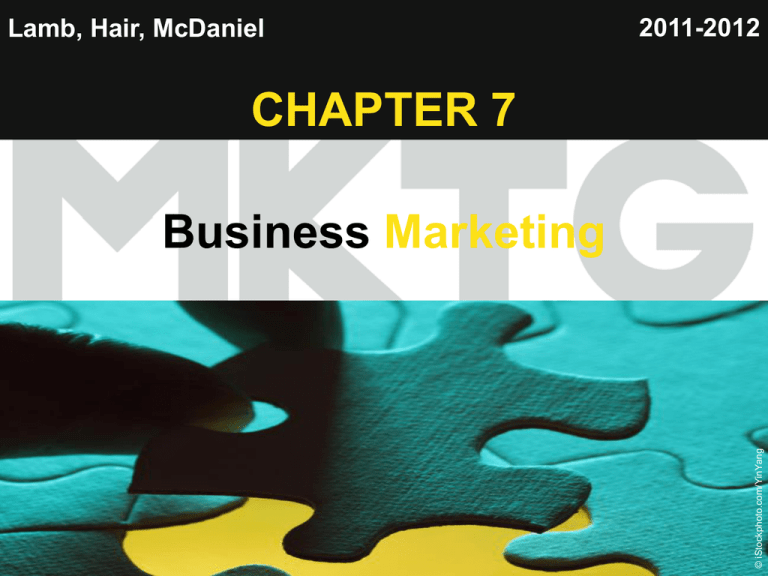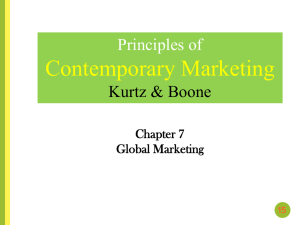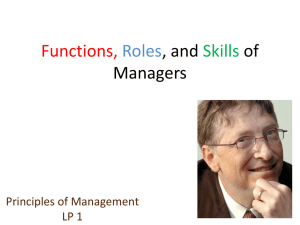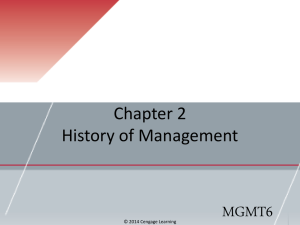
Lamb, Hair, McDaniel
2011-2012
CHAPTER 7
Chapter 7
Copyright ©2012 by Cengage Learning Inc. All rights reserved
1
© iStockphoto.com/YinYang
Business Marketing
What Is Business Marketing?
Describe business
marketing
LO1
Chapter 7
Copyright ©2012 by Cengage Learning Inc. All rights reserved
2
What Is
Business Marketing?
Business
Marketing
The marketing of goods
and services to individuals
and organizations for
purposes other than
personal consumption.
LO1
Chapter 7
Copyright ©2012 by Cengage Learning Inc. All rights reserved
3
Business Products
The key is intended use.
Business Products:
•
Are used to manufacture other products
•
Become part of another product
•
Aid the normal operations of an organization
•
Are acquired for resale without change in form
LO1
Chapter 7
Copyright ©2012 by Cengage Learning Inc. All rights reserved
4
Business Marketing
on the Internet
Describe the role of
the Internet in
business marketing
LO2
Chapter 7
Copyright ©2012 by Cengage Learning Inc. All rights reserved
5
Business-to-Business
Business-to-business electronic
commerce is…
the use of the Internet to facilitate the
exchange of goods, services, and
information between organizations.
LO2
Chapter 7
Copyright ©2012 by Cengage Learning Inc. All rights reserved
6
Measuring Online Success
Stickiness
A measure of a Web site’s
effectiveness; calculated by
multiplying the frequency of
visits by the duration of a visit
by the number of pages viewed
during each visit.
Stickiness = Frequency x Duration x Site Reach
LO2
Chapter 7
Copyright ©2012 by Cengage Learning Inc. All rights reserved
7
Exhibit 7.2
Evolution of EBusiness Initiatives
LO2
Chapter 7
Copyright ©2012 by Cengage Learning Inc. All rights reserved
8
Relationship Marketing
and Strategic Alliances
Discuss the role
of relationship
marketing and
strategic alliances in
business marketing
LO3
Chapter 7
Copyright ©2012 by Cengage Learning Inc. All rights reserved
9
Relationship Marketing
• Loyal customers are more profitable
than price-sensitive customers with
little brand loyalty
• Long-term relationships build
competitive advantage
LO3
Chapter 7
Copyright ©2012 by Cengage Learning Inc. All rights reserved
10
Strategic Alliances
• Licensing or distribution agreements
• Joint ventures
• Research and development consortia
• Partnerships
Alliances succeed with commitment and
trust.
LO3
Chapter 7
Copyright ©2012 by Cengage Learning Inc. All rights reserved
11
Relationships
in Other Cultures
Keiretsu relationships are highly integrated:
• Companies have executives sitting
on each others’ boards
• Maintain dedicated trade efforts
• Joint development, finance, and
marketing
LO3
Chapter 7
Copyright ©2012 by Cengage Learning Inc. All rights reserved
12
Major Categories of
Business Customers
Identify the four major
categories of business
market customers
LO4
Chapter 7
Copyright ©2012 by Cengage Learning Inc. All rights reserved
13
Major Categories of
Business Customers
Producers
Resellers
Governments
LO4
Chapter 7
Institutions
• OEMs
• Wholesalers
• Retailers
• Federal
• State
• Local
• Schools
• Hospitals
• Colleges
• Churches
• Unions
• Fraternal
• Civic Clubs
• Foundations groups
• Nonbusiness organizations
Copyright ©2012 by Cengage Learning Inc. All rights reserved
14
North American
Industry Classification System
Explain the North
American Industry
Classification System
LO5
Chapter 7
Copyright ©2012 by Cengage Learning Inc. All rights reserved
15
NAICS
NAICS
North American
Industry
Classification
System
A detailed numbering system
developed by the U.S.,
Canada, and Mexico to classify
North American business
establishments by their main
production processes.
LO5
Chapter 7
Copyright ©2012 by Cengage Learning Inc. All rights reserved
16
Example of NAICS Hierarchy
NAICS
Level
Sector
Subsector Industry Industry Industry
Group
Subdivision
NAICS
Code
51
513
Descript Information
ion
5133
Broadcasting Telecoms
and telecoms
51332
513321
Wireless
telecoms
carriers,
except
satellite
Paging
LO5
Chapter 7
Copyright ©2012 by Cengage Learning Inc. All rights reserved
17
NAICS
• Provides a common industry classification
system
• Valuable tool for marketers in analyzing,
segmenting, and targeting markets
• Data can be used to determine:
LO5
Chapter 7
– Number, size, and geographic dispersion of
firms
– Market potential / market share estimates
– Sales forecasts
– New customer identification
Copyright ©2012 by Cengage Learning Inc. All rights reserved
18
Business versus
Consumer Markets
Explain the major
differences between
business and
consumer markets
LO6
Chapter 7
Copyright ©2012 by Cengage Learning Inc. All rights reserved
19
LO6
Business versus
Consumer Markets
Characteristic
Business Market
Consumer Market
Demand
Organizational
Individual
Volume
Larger
Smaller
# of Customers
Fewer
Many
Location
Concentrated
Dispersed
Distribution
More Direct
More Indirect
Nature of Buying More Professional
More Personal
Buy Influence
Multiple
Single
Negotiations
More Complex
Simpler
Reciprocity
Yes
No
Leasing
Greater
Lesser
Promotion
Personal Selling
Advertising
Chapter 7
Copyright ©2012 by Cengage Learning Inc. All rights reserved
20
LO6
Demand in Business Markets
Demand is...
Description
Derived
Demand for business products results from
demand for consumer products.
Inelastic
A change in price will not significantly
affect the demand for product.
Joint
Fluctuating
Chapter 7
Multiple items are used together in final
product. Demand for one item affects all.
Demand for business products is more
volatile than for consumer products.
Copyright ©2012 by Cengage Learning Inc. All rights reserved
21
Fluctuating Demand
Multiplier Effect
(Accelerator
Principle)
Phenomenon in which a small
increase or decrease in
consumer demand can
produce a much larger change
in demand for the facilities and
equipment needed to make
the consumer product.
LO6
Chapter 7
Copyright ©2012 by Cengage Learning Inc. All rights reserved
22
Types of Business Products
Describe the seven
types of business
goods and services
LO7
Chapter 7
Copyright ©2012 by Cengage Learning Inc. All rights reserved
23
LO7
Types of Business Products
Major Equipment
Accessory Equipment
Raw Materials
Component Parts
Processed Materials
Supplies
Business Services
Chapter 7
Copyright ©2012 by Cengage Learning Inc. All rights reserved
24
Types of Business Goods and Services
LO7
Chapter 7
Copyright ©2012 by Cengage Learning Inc. All rights reserved
25
Business Buying Behavior
Discuss the unique
aspects of business
buying behavior
LO8
Chapter 7
Copyright ©2012 by Cengage Learning Inc. All rights reserved
26
Business Buying
Behavior
Buying Centers
Evaluative Criteria
Aspects of
Business
Buying
Behavior
Buying Situations
Business Ethics
LO8
Chapter 7
Customer Service
Copyright ©2012 by Cengage Learning Inc. All rights reserved
27
Buying Centers
Buying Center
• Number of people
involved varies with
each purchase
decision
LO8
Chapter 7
All those people in an
organization who
become involved in the
purchase decision.
• Buying centers do
not appear on
formal organization
charts
Copyright ©2012 by Cengage Learning Inc. All rights reserved
28
Roles in Buying Centers
Initiator
Influencers
Gatekeepers
Decider
Purchaser
Users
LO8
Chapter 7
Copyright ©2012 by Cengage Learning Inc. All rights reserved
29
Evaluative Criteria
Quality
Service
Price
LO8
Chapter 7
Copyright ©2012 by Cengage Learning Inc. All rights reserved
30
Buying Situations
New Buy
A situation requiring the purchase of
a product for the first time.
Modified
Rebuy
A situation where the purchaser
wants some change in the original
good or service.
Straight
Rebuy
A situation in which the purchaser
reorders the same goods or services
without looking for new information
or investigating other suppliers.
LO8
Chapter 7
Copyright ©2012 by Cengage Learning Inc. All rights reserved
31
Customer Service
Divide customers into groups based
on their value
Create policies that govern how
service will be allocated among
groups
LO8
Chapter 7
Copyright ©2012 by Cengage Learning Inc. All rights reserved
32









